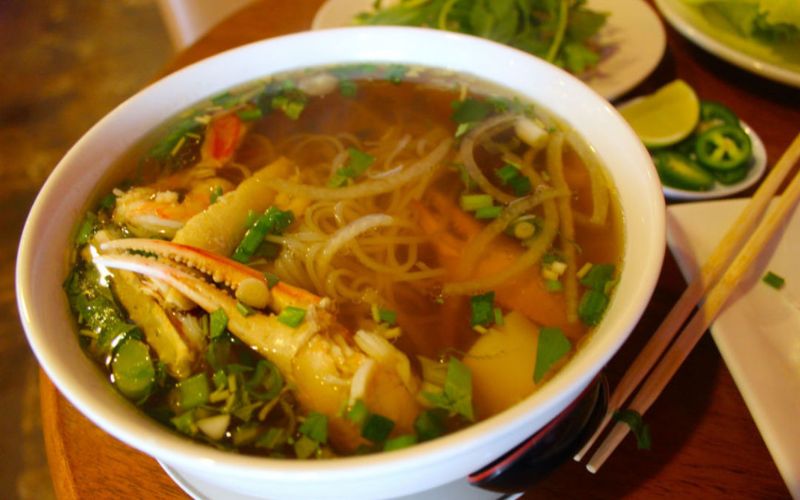Discover the ultimate crab pho recipe that combines authentic Vietnamese flavors with nutritious ingredients perfect for family meals. This comprehensive guide helps parents create restaurant-quality crab pho at home, offering a delicious and healthy alternative that children will love while providing essential nutrients for growing bodies.
Introduction
Vietnamese cuisine is known for its fresh ingredients, aromatic herbs, and complex flavors, with pho being a standout dish. While beef and chicken pho are traditional favorites, crab pho offers a unique seafood twist, bringing both exceptional flavor and nutritional benefits to the table.
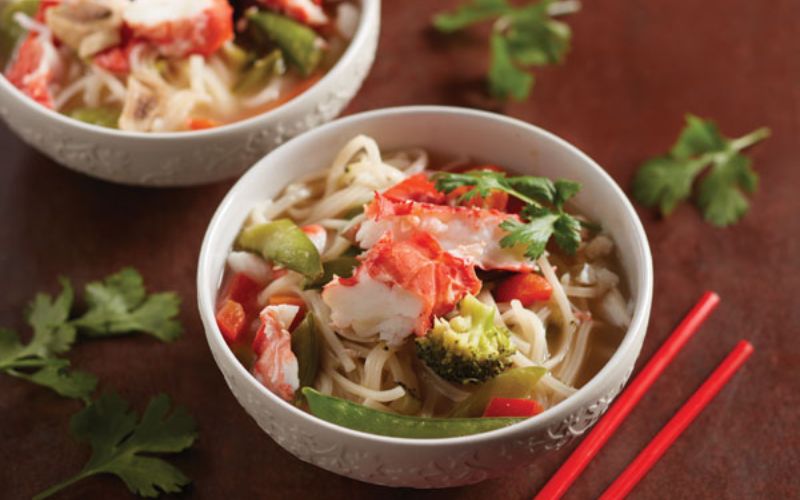
Crab pho is an ideal meal for families, especially for children, as it combines the comfort of noodle soup with the sweet taste of fresh crab. The broth is rich in vitamins and minerals, while the crab meat provides high-quality protein for growth. Making crab pho at home allows families to ensure food safety and tailor the dish to dietary needs. This guide will help you create restaurant-quality crab pho with ease.
What is crab pho?
Crab pho is a refined twist on traditional Vietnamese pho, replacing beef or chicken with fresh crab. Originating in coastal regions rich in seafood, it features a clear, aromatic broth infused with spices like star anise and cinnamon, served over rice noodles and topped with fresh herbs. The addition of crab shells and bodies enhances the broth with umami flavors and essential minerals.
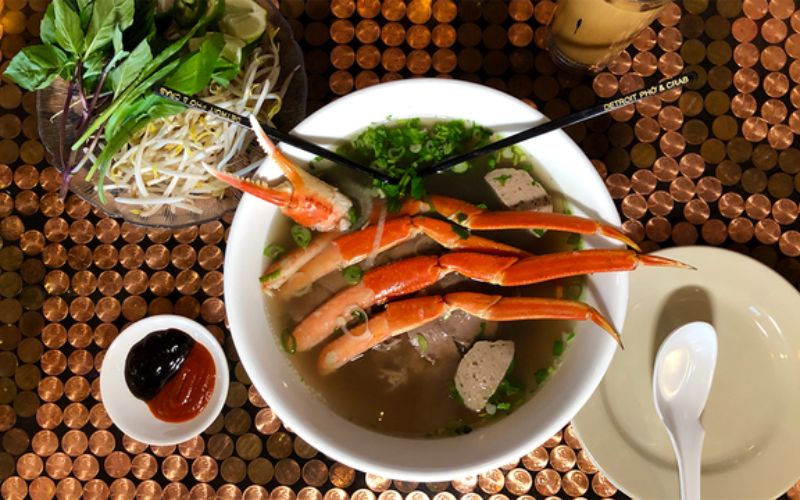
Crab pho is a lighter, health-conscious alternative to meat-based soups, appealing to families seeking nutritious options. With variations like whole crab pieces, crab meat, or even crab cakes and seafood combinations, it offers something for all tastes. For children, crab pho is an excellent introduction to seafood, with its familiar noodle soup format and sweet crab flavor making it more accessible and fun.
Crab pho vs traditional pho
Traditional beef pho relies on lengthy simmering of beef bones, particularly marrow-rich leg bones and knuckle bones, to create its characteristic rich, deeply flavored broth. This process typically requires 12-24 hours of gentle cooking to extract maximum flavor and gelatin content. In contrast, crab pho achieves its signature taste through a shorter but equally important process that focuses on extracting sweet, briny flavors from crab shells and bodies, usually completing within 2-4 hours.

The flavor profile differences are immediately apparent to experienced pho enthusiasts. Traditional beef pho delivers earthy, robust flavors with pronounced umami depth, while crab pho offers lighter, more delicate tastes with pronounced sweetness and subtle ocean notes. This makes crab pho particularly appealing to children who might find traditional beef pho too intense or overwhelming.
Nutritionally, crab pho provides distinct advantages for growing families. Crab meat contains high levels of vitamin B12, zinc, and selenium, nutrients essential for children’s cognitive development and immune system function. The lower fat content compared to beef-based versions makes crab pho suitable for families managing weight concerns or seeking lighter meal options.
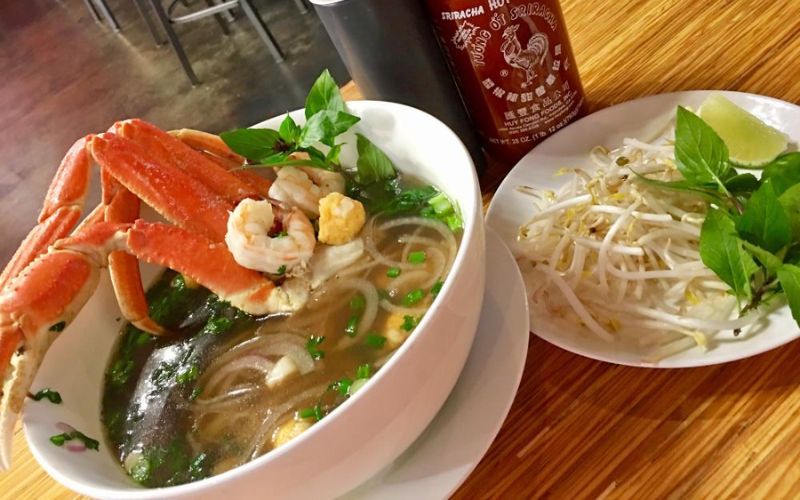
Preparation complexity also differs significantly between these variations. While traditional pho requires careful attention to bone selection and extended cooking times, crab pho allows for more flexible timing and ingredient substitutions, making it more accessible for busy parents balancing work and family responsibilities.
Health benefits of crab pho
Crab pho is a nutritious meal ideal for health-conscious families, combining fresh crab meat, aromatic herbs, and mineral-rich broth. The crab meat offers high-quality, lean protein (20-25 grams per serving), supporting muscle development, tissue repair, and stable energy levels. It’s an excellent protein choice, especially for children, while also delivering essential amino acids for growth.

In addition to protein, crab pho is packed with minerals like zinc and selenium, which support immune function, wound healing, and thyroid health. Vitamin B12 in crab is crucial for nervous system development and red blood cell formation, making it a great option for families on plant-based diets. The herbs in crab pho add antioxidants, vitamin C, and digestive support, making this dish a well-rounded choice for overall health and wellness.
Essential tools and equipment
To make restaurant-quality crab pho at home, you’ll need the following tools:
- Large stockpot (8-10 quarts): Essential for simmering crab shells, aromatics, and water. Stainless steel or enameled cast iron ensures even heat distribution.
- Fine-mesh strainers (multiple sizes): Used for creating clear broth. A coarse strainer removes large particles, while fine-mesh strainers eliminate smaller impurities. Cheesecloth can help achieve crystal-clear broth.
- Crab tools: Crab crackers, picks, and small hammers assist in efficiently removing shells and extracting meat, speeding up preparation.

- Large skimming ladle: Removes foam and impurities from the broth for a clean-tasting result.
- Instant-read thermometer: Ensures proper temperature control for both the broth and noodles, ensuring consistency.
Traditional crab pho recipe
This authentic crab pho recipe has been refined through years of experience working with Vietnamese families and professional kitchens, ensuring reliable results that capture the true essence of this beloved seafood dish. The recipe serves 4-6 people and can be easily scaled up for larger gatherings or meal preparation.
Ingredients
The success of exceptional crab pho depends heavily on ingredient quality and proper proportions. Fresh, live crabs provide the best flavor, though high-quality frozen options work well when fresh isn’t available. The following ingredient list ensures authentic taste and optimal nutritional value:
For the broth:
- 3-4 pounds fresh Dungeness or blue crabs, cleaned and quartered
- 2 pounds pork or chicken bones (optional, for added richness)
- 1 large onion, halved and charred
- 4-inch piece fresh ginger, halved and charred
- 6 star anise pods
- 4 whole cloves
- 2 cinnamon sticks
- 1 tablespoon coriander seeds
- 1 teaspoon fennel seeds
- 2 tablespoons fish sauce
- 1 tablespoon rock sugar or brown sugar
- Salt to taste
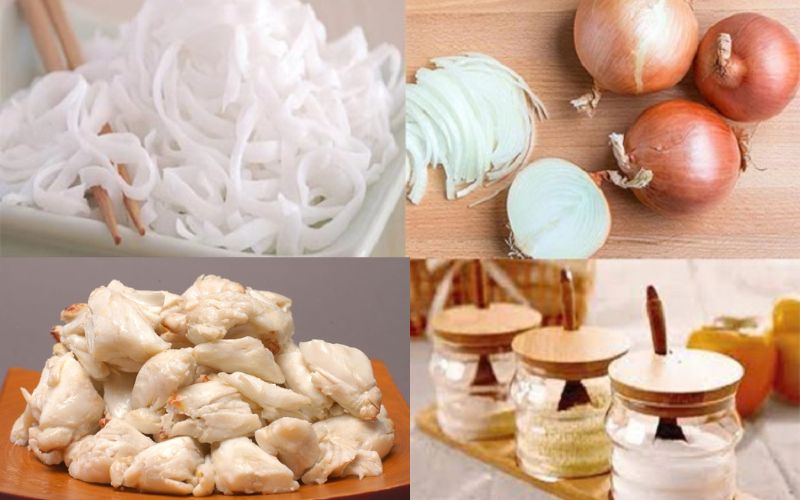
For serving:
- 1 pound fresh rice noodles (banh pho)
- 1 pound fresh crab meat, picked clean
- 4 green onions, thinly sliced
- 1/4 cup fresh cilantro leaves
- 1/4 cup fresh Thai basil leaves
- 1/4 cup fresh mint leaves
- 2 limes, cut into wedges
- Bean sprouts for garnish
- Sliced jalapeños for heat
Preparation steps
Proper preparation forms the foundation of exceptional crab pho, requiring attention to detail and careful timing to achieve optimal results. Begin preparation at least 4-5 hours before serving to allow sufficient time for broth development and flavor integration.
- Clean the crabs: Rinse under cold water, removing sand and debris. For live crabs, freeze for 30 minutes before cleaning. Remove top shells, gills, and internal organs, reserving shells for the broth. Quarter the crab bodies and crack the claws for better flavor extraction.
- Char the onion and ginger: Char over an open flame or under a broiler until dark spots form. This adds depth to the broth. Let them cool slightly before adding to the stockpot.
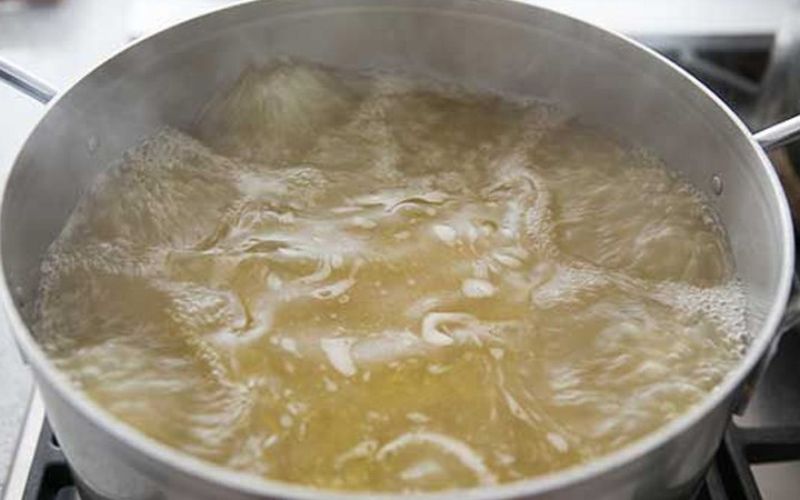
- Toast whole spices: Toast star anise, cloves, cinnamon, coriander, and fennel in a dry pan for 2-3 minutes until fragrant. Wrap in cheesecloth to make a bouquet garni for easy removal.
Cooking instructions
The cooking process for crab pho requires patience and careful attention to achieve the clear, flavorful broth that defines excellent pho. Proper technique during this stage determines the final quality and taste of the finished dish.
- Prepare the broth: Place crab pieces and optional bones in a large stockpot, cover with cold water (2-3 inches above crab). Bring to a gentle boil, then reduce to a low simmer. Skim foam and impurities for the first 30 minutes, maintaining a simmer throughout.
- Add aromatics: Add charred onion, ginger, and spice bundle to the pot. Simmer for 2-3 hours, adding hot water as needed to maintain water levels. The broth should develop a light amber color and rich aroma.
- Strain and season: Strain the broth through fine-mesh strainers lined with cheesecloth. Discard solids and reserve the liquid. Return broth to the pot and season with fish sauce, sugar, and salt to taste.

- Prepare noodles: Cook rice noodles according to package directions, soaking until tender. Only cook what’s needed to prevent mushiness.
- Assemble: Place noodles in bowls, top with fresh crab meat, and ladle hot broth over them.
Cooking tips and techniques
Mastering crab pho requires understanding specific techniques that ensure consistent, professional-quality results every time you prepare this sophisticated dish. These expert tips, developed through extensive experience with seafood cookery, help home cooks avoid common pitfalls while maximizing flavor development.
Selecting crab
Choosing the right crab is key to making exceptional crab pho. Fresh, live crabs offer the best flavor and texture. Look for crabs that feel heavy for their size, indicating full meat content and good hydration. They should be active and responsive when handled, with vibrant, unblemished shells. Avoid crabs with cracked shells, missing limbs, or a strong fishy odor.
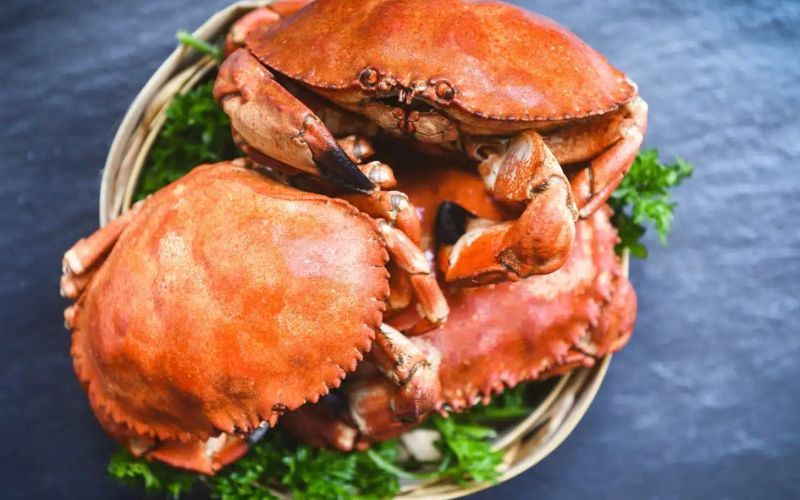
If fresh crabs aren’t available, high-quality frozen crabs can still produce great results. Choose crabs that are properly glazed and stored without signs of freezer burn. Thaw them slowly in the refrigerator overnight to maintain texture. Different regional crab varieties, such as Dungeness, blue, or king crabs, offer unique flavor profiles, from sweet and delicate to briny and intense, enhancing the broth in various ways.
Cleaning crab
Proper crab cleaning is essential for both food safety and maximizing flavor in crab pho. Start by rinsing the crabs under cold water with a stiff brush to remove sand, seaweed, and debris, focusing on the underside of the shell and leg segments. This prevents gritty textures and off-flavors in the broth.
Next, remove the top shell by lifting it from the rear, then discard the gills and internal organs, reserving the shells for the broth. The green matter (tomalley) can be saved for extra richness or discarded for a cleaner flavor. Quarter the crab bodies with kitchen shears or a heavy knife to expose the meat and create optimal surface area for flavor extraction. Crack the claws and leg segments for better broth penetration and easier meat removal later.
Making the broth
The broth is the heart of great crab pho, requiring careful temperature control and ingredient balance. Keep the water temperature just below boiling (185-195°F) to avoid cloudiness and bitter flavors. Use a thermometer to ensure consistent temperature for optimal flavor extraction without overcooking.

Regularly skim foam and impurities during the first hour to maintain a clear, clean broth. Use a wide ladle to efficiently remove foam without disturbing the aromatics. Add hardy ingredients like onion and ginger early, and delicate herbs toward the end to ensure each contributes its best flavor without becoming bitter.
Preparing noodles
Proper handling of rice noodles is key to achieving the right texture for crab pho. Soak dried noodles in warm water (not hot) for 15-30 minutes until they’re pliable but firm in the center. This ensures they cook properly when hot broth is added.
Rinse the soaked noodles in cold water to remove excess starch, preventing a gummy texture and cloudy broth. Drain well and serve in warmed bowls to maintain the dish’s temperature. Fresh noodles require
Make-ahead and storage tips
Planning crab pho preparation around busy family schedules requires understanding proper make-ahead techniques and storage methods that preserve quality while maximizing convenience. These strategies help parents provide nutritious, homemade meals without extensive daily preparation time.
- Broth: Make 1-2 days ahead. Cool quickly in an ice bath, then store in airtight containers in the fridge for up to 3 days or freeze for up to 3 months.
- Crab Meat: Pick crab meat up to 24 hours in advance. Store in airtight containers with plastic wrap directly on the surface to prevent oxidation.
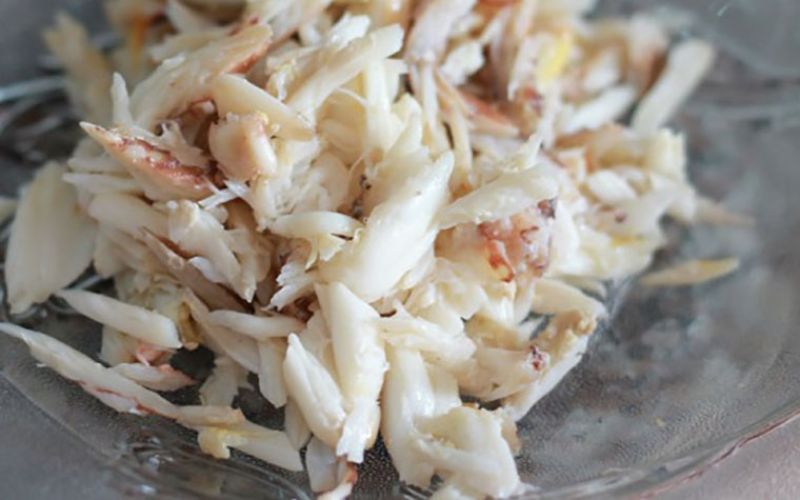
- Herb Garnishes: Wash, dry, and store herbs in damp paper towels within plastic bags in the fridge. Use cilantro and Thai basil within 1-2 days; other herbs last 2-3 days.
- Green Onions: Slice and store in airtight containers for up to 1 week.
- Rice Noodles: Do not pre-cook. Store dried noodles in portioned amounts in airtight containers in a cool, dry place.
Common mistakes to avoid
Understanding frequent crab pho preparation errors helps home cooks achieve consistent, restaurant-quality results while avoiding disappointments that discourage future attempts. These common mistakes often stem from unfamiliarity with seafood cookery or attempting to rush the traditional slow-cooking process.
- Overcooking the Broth: Overheating creates bitterness and cloudiness, masking crab flavors. Keep the temperature low and simmer gently to maintain clarity and enhance flavor.
- Using Low-Quality Crab: Poorly stored or low-quality crab can spoil the dish. Always use the freshest crab available to ensure the best broth.

- Inadequate Seasoning: Undercooked or unbalanced seasoning leads to a bland broth. Adjust seasoning during the cooking process, especially toward the end, to ensure a complex, well-rounded flavor.
- Preparing Components Too Early: Preparing ingredients too far in advance can result in quality loss. Plan ahead, but time each component’s preparation to maintain optimal freshness and flavor.
How to serve crab pho
Proper crab pho presentation enhances the dining experience while honoring the Vietnamese traditions that created this beloved dish. Understanding authentic serving methods helps families appreciate the cultural significance while ensuring optimal enjoyment for diners of all ages.
- Warm serving bowls thoroughly before assembling crab pho, preventing rapid temperature loss that could compromise the eating experience. Place a portion of prepared rice noodles in each bowl, arranging them neatly in the bottom without packing them tightly. Top with fresh crab meat, distributing it evenly for fair portions among all diners.
- Ladle the hot broth carefully over the noodles and crab meat, ensuring sufficient liquid to cover all components while leaving room for garnishes. The broth should be steaming hot when served, maintaining temperature throughout the meal. Add sliced green onions and fresh herbs as the final touches before bringing to the table.

- Present accompaniment dishes family-style, allowing each person to customize their crab pho according to personal preferences. Include lime wedges, bean sprouts, sliced jalapeños, and additional fresh herbs on separate plates. This interactive serving style engages children in the dining experience while respecting individual taste preferences.
- Provide appropriate utensils including chopsticks, Asian soup spoons, and small plates for shells and discarded items. Teaching children proper eating techniques for crab pho becomes part of the cultural education that makes family meals memorable and meaningful. Demonstrate how to combine noodles, broth, and garnishes for optimal flavor balance.
Conclusion
Crab pho is a valuable addition to any family’s meals, offering authentic Vietnamese flavors and exceptional nutritional benefits that support healthy growth in children. This guide equips parents with the tools to create restaurant-quality crab pho at home, turning a seemingly complex dish into an achievable family meal.
Crab pho provides high-quality protein, essential minerals, and vitamins that aid children’s cognitive development, immune function, and overall health. The addition of antioxidant-rich herbs and easily digestible rice noodles ensures a complete, nutritious meal. Beyond its nutritional value, crab pho offers families a chance to explore Vietnamese culture and enjoy interactive dining experiences, from adding garnishes to learning chopstick techniques.
For any inquiries, please feel free to reach out to us through the following channels:
Anh Kim Food Production Joint Stock Company (AK FOOD)
Phone number: +84 28 3815 9696
Email: contact@akfood.com.vn
Address: Lot III – 1B, Street 1, Tan Binh Industrial Park, Tan Phu District, Ho Chi Minh City, Vietnam


 Tiếng Việt
Tiếng Việt